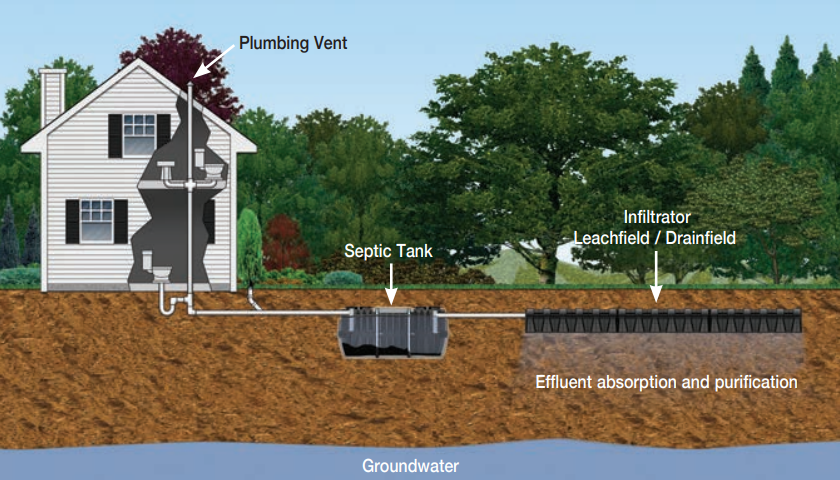
What Is A Septic Tank & How Does It Work?
What Is a Septic Tank & How It Works in the UK (And Why D-tox Has You Sorted!)
For many homes and businesses in rural Britain, or those off the main drainage grid, a septic tank is an unsung hero. It quietly processes your wastewater without fuss. But what exactly is one, how does it work, and crucial for us Brits, how do you keep it running smoothly and legally?
Let’s dive in!
What on Earth is a Septic Tank?
Simply put, a septic tank is an underground, watertight container – usually made of fibreglass, plastic, or concrete. It's your very own miniature, on-site sewage treatment plant, typically handling all the wastewater from your sinks, showers, toilets, and washing machine.
They're a common sight in the UK's countryside, in charming cottages, remote farmhouses, and even some tucked-away commercial properties that aren't hooked up to the mains drainage system. It's important to remember that a septic tank isn't the same as an effluent tank, which is more for temporary holding – we hire those out too, by the way!
How Does This Underground Wonder Work?
The process is quite clever, really:
- Inlet: All the wastewater from your property flows into the septic tank via an inlet pipe.
- Separation: Once inside, the magic happens. The wastewater slows down, allowing solids to sink to the bottom, forming a layer called "sludge." Lighter bits like oils and grease float to the top, creating a "scum" layer. In the middle, you're left with pre-processed liquid.
- Bacterial Breakdown: Bacteria naturally present in the tank get to work, breaking down a lot of the solid waste. This is why it’s vital not to pour harsh chemicals down your drains, as they can kill these helpful little chaps!
- Effluent Out: The treated liquid, now called "effluent," then flows out of the tank through an outlet pipe into a drain field (sometimes called a soakaway). This is a series of trenches or a bed of gravel where the effluent slowly seeps into the soil. The soil then acts as a natural filter, cleaning the water further before it re-enters the groundwater or local watercourses.
Don't Let it Go Pear-Shaped: Why Regular Emptying is Crucial!
While your septic tank does a grand job of breaking down waste, it's not a magical bottomless pit. That sludge at the bottom does accumulate over time and needs to be removed.
Neglecting your septic tank can lead to a right mess – unpleasant odours, backed-up drains (a proper nightmare!), and even costly damage to your drain field or, heaven forbid, a backup into your home! In the UK, it’s generally recommended to have your tank emptied annually or every couple of years, depending on usage and tank size, to keep it running like a dream and comply with environmental standards.
Is Your Septic Tank Calling for Help?
- Slow drains or gurgling toilets?
- Foul odours inside or outside your property?
- Pooling water or lush green patches near your drain field?
- Back-ups in your household plumbing (the absolute worst!)
If you spot any of these warning signs, it’s definitely time to call in the professionals. D-tox offers rapid response septic tank emptying to sort things out sharpish! We've got a fleet of tankers ranging from 500 right up to a whopping 4000 gallons, so no job's too big (or too mucky) for us. We'll ensure your system is clean, compliant, and causing no bother.
Ready for a hassle-free empty? Get your quote for septic tank emptying with D-tox now!

Beyond the Septic Tank: D-tox Has You Sorted for More!
While we're experts in septic tanks, D-tox Group is your proper 'one-stop shop' for everything water and effluent across the West Midlands.
Need portable loos for your next project or event? If you're managing a construction site that isn't connected to mains drainage, or planning a big outdoor shindig in a rural spot, you'll definitely need top-notch facilities. From standard site loos and hot wash units for welfare facilities to accessible toilets and multi-bay urinals for events, we've got the perfect solution to keep everyone comfortable.
Why Choose D-tox? We Make it a Doddle!
At D-tox, we don't just shift muck; we deliver peace of mind. Our team, backed by our JobWatch system, ensures spot-on scheduling. You'll even get Proof of Delivery (POD) sent immediately after the job's done, so you know everything's sorted, no fuss, no bother.
Whether it's regular septic tank maintenance, emergency emptying, or providing the best portable toilets for your construction site or event, D-tox Group is here to ensure your waste management is sorted.
Need a Septic Tank Emptying Quote or Portable Toilet Hire in the West Midlands?
Get in touch with the friendly D-tox team today!
📞 Call us on 0800 999 2260
📧 Email us at info@dtox.org





